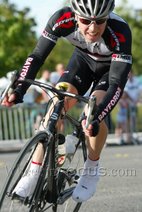
by Coach Lang Reynolds
The Winter Solstice is now behind us and in theory we have crossed the depth of winter and are climbing back towards the light of better conditions for training, but in reality we are far from being out of the woods when it comes to the dank weather and short daylight hours that make conventional training for cycling difficult at this time of year.
Here at Cycle University we recommend taking a short break from cycling some time during the fall or winter, and we also encourage our athletes to stay in shape while participating in activities other than their primary discipline of cycling. Cross-training (running, XC skiing, swimming, etc.) is an excellent way to maintain aerobic fitness while taking a mental break from continuous training on the bike. Nonetheless, structured training on the bike throughout the winter is the best way to maintain and improve cycling fitness. Coming out of the winter season with improved fitness will allow you to start training next spring at a higher level, which in turn will allow you to meet and exceed whatever goals you have planned for 2008.
The following are some ideas on how to keep winter training fun and productive:
Race Cyclocross!
Cyclocross (off-road racing on a road bike with knobby tires) has arguably the highest fun/effort ratio of any cycling discipline. The intensity of the weekly races alone is enough to boost your fitness throughout the fall, and the technical off-road courses challenge you to improve your handling skills at the same time. Local venues and short circuits make this cycling discipline very approachable for the beginner as well as spectator friendly. This year’s cross season is already over, but it’s not too early to start thinking about next year. For more information check out Seattle Cyclocross.
Indoor Training
In Seattle in the winter, it is often next to impossible to fit in an outside ride during daylight hours if you hold a regular job in the real world. With the proper equipment (lights and fenders) riding outside at night is possible, but in order to really ride at the intensities that most efficiently stimulate improvements in performance, indoor riding is the most productive solution.
The most important piece of equipment for any cyclist who wishes to train indoors is a structured training plan. This keeps you on track and provides each workout with a purpose, avoiding the boredom and tedious nature of most indoor riding.
Another important piece of “equipment” for any cyclist training indoors is a group of people with whom to suffer. Suffering in a group is much more tolerable than suffering alone. Here at Cycle University our InCycle group cycling class incorporates a structured training plan to not only maintain your fitness over the winter but also prepares you to reach a whole new level in 2008. We also offer the CycleU Indoor TT, a weekly series of indoor races on our CompuTrainer Multirider setup, which is a great opportunity to put in a weekly effort at race intensity.
If you prefer to train in the comfort of your own home, there are a few must-have items:
Trainer – A trainer allows use of your own bike (instead of a stationary bike or similar) and keeps you adapted to your riding position. A high-quality fluid trainer will provide a range of resistance without rider adjustment for all training intensities.
Rollers – Requiring more concentration than a static trainer, a set of rollers is a great addition to the indoor training arsenal. Switching between the trainer for focused interval days and the rollers for shorter fitness spins will stave off monotony and improve your handling skills at the same time.
Entertainment – This is another must-have for indoor training. A movie to watch and music to listen to will make the time fly!
Cooling – Unlike riding outdoors where cooling is provided by the wind, indoor riding can become uncomfortably hot. Several fans and an open window can go a long ways towards making indoor workouts more comfortable.
Here at the beginning of 2008 we still have several months of cold, dark, and wet weather ahead of us. For many of you, though, this year’s goal may not be as far off as they seem, and you will soon be training in earnest. In order to make the most of your spring and summer training it’s important to start off with a good foundation of fitness, best laid right now when the going is tough. Using a structured indoor training plan and the tools above will make indoor training fun, productive better than ever.



